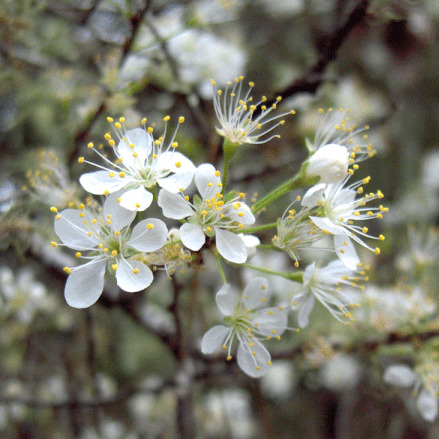Shrubs or trees, often suckering, 10–50 dm, thorny. Twigs with axillary end buds, glabrous. Leaves deciduous; petiole 2–14 mm, usually sparsely hairy on adaxial surface, rarely glabrous or hairy on both surfaces, usually eglandular, sometimes glandular distally, glands 1–2; blade lanceolate to narrowly elliptic, ?usually folded along midribs, often ± falcate?, 1.5–6 × 0.8–2 cm, base cuneate to obtuse, margins crenulate-serrulate, teeth blunt, glandular, ?glands reddish orange, conic?, apex acute, abaxial surface glabrate with hairs along midribs and major veins, adaxial glabrous. Inflorescences 2–4-flowered, umbellate fascicles. Pedicels 3–10 mm, glabrous. Flowers blooming before, sometimes at, leaf emergence; hypanthium campanulate, 1.5–3 mm, usually glabrous, rarely hairy, externally; sepals erect to spreading, ovate, 1–2 mm, margins entire, ?sparsely ciliate?, abaxial surface glabrous, adaxial hairy; petals white, suborbiculate to obovate, 3–6 mm; ovaries glabrous. Drupes red to yellow, ?lightly glaucous?, globose to ellipsoid, 15–20 mm, glabrous; mesocarps fleshy; stones ovoid, ± flattened. 2n = 16.
More
Much-branched, often thorny shrub or small tree to 5 m, forming thickets; lvs scarcely developed at anthesis, at maturity trough-shaped, lanceolate to narrowly elliptic or oblanceolate, 3–6 cm, acute or short-acuminate, smooth and shining above, very finely serrulate, the teeth 12–20 per cm, bearing a gland near the sinus; pedicels (3–8 mm), hypanthium, and outer side of the sep smooth or nearly so, the inner side of the sep hairy especially near the base; pet 4–6 mm; fr subglobose, red, not glaucous, 1–1.5 cm thick; stone turgid. Usually in sandy or sterile soil, open woods, thickets, and fence-rows; chiefly from Va. to Fla., w. to Kans. and Tex., but also irregularly to s. N.J., s. O., Ind., Ill., and Neb. Apr.
A shrub or small tree. It forms thickets. The branches are slender and spreading. It grows 1.5-4.6 m high. The trunk is 10 cm across. The bark is shiny and reddish. It is thin and forms slight cracks. The leaves are 2.5-6 cm long by 1-2.5 cm wide. They are sword shaped with the sides slightly curved up. There are sharp teeth along the edge. The leaves are shiny green above and dull and paler underneath. The leaf stalks are red and slender. The flowers are 10 mm wide with 5 rounded white petals. There are 2-4 flowers in clusters on short equal stalks. The fruit is a plum 12-19 mm across. The skin is shiny red or yellow. There is a thick, juicy edible pulp. There is a large stone.
Usually found in sandy soils, occurring along fence rows, in pastures, fields, open woods, stream banks, sand dunes and disturbed sites, often forming thickets; at elevations up to 600 metres.
More
Temperate. It grows in moist soils. It the SE region of the USA it grows to 900 m altitude. It suits hardiness zone 5.


